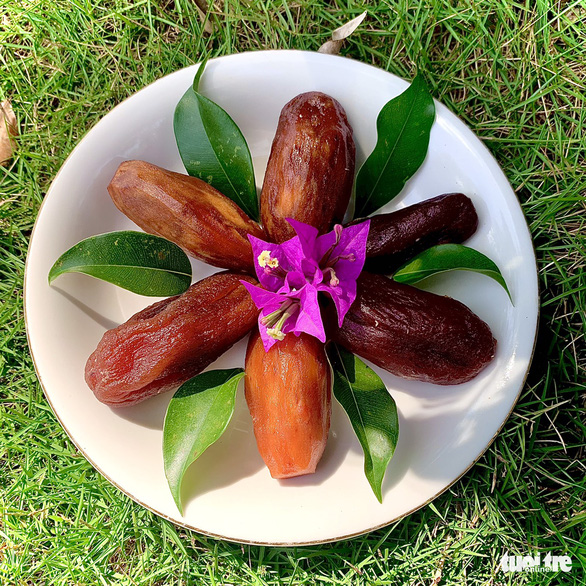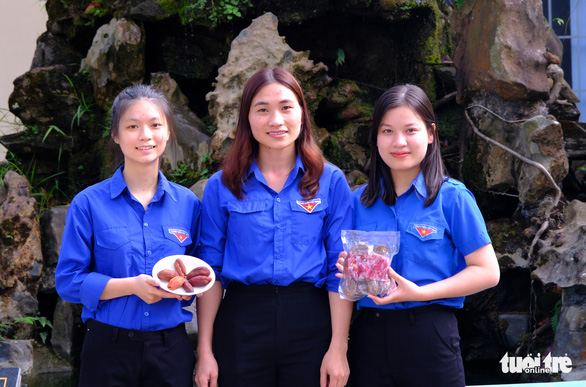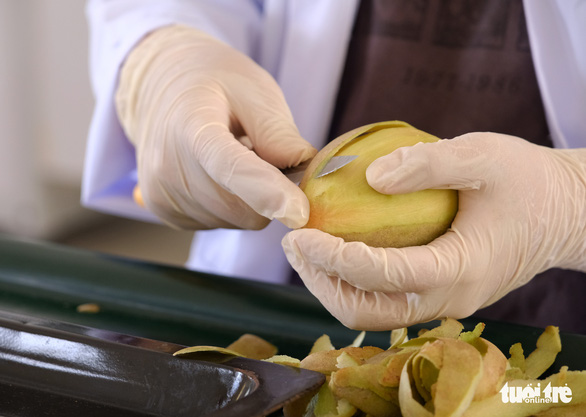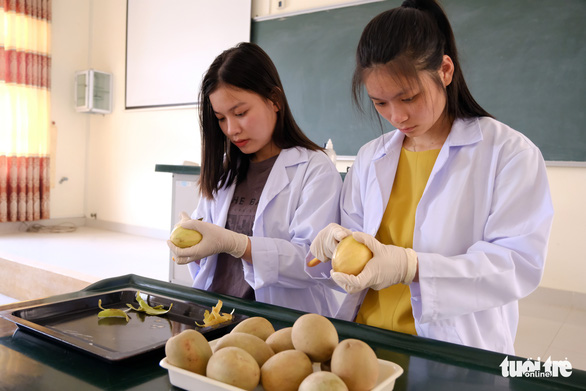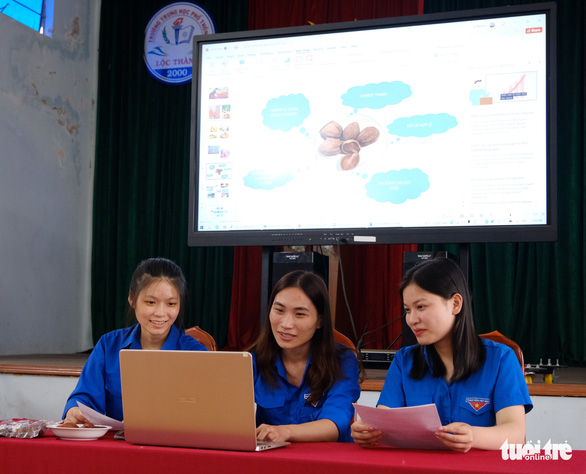Inspired by a similar product from Da Lat, a resort city in Vietnam's Central Highlands region, a chemistry teacher and two students have developed an innovative technology for drying sapodilla and turned it into a new specialty.
Aiming to find a new way for their hometown's agricultural delicacy, teacher Vu Thi Hang and her students Nguyen Huyen Bao Tram and Le Thi Ngoc Anh at Loc Thanh High School in Bao Lam District, Lam Dong Province want to do something new with sapodilla, a type of tropical fruit that is popular in their homeland.
They set out to develop a perfect process to air-dry the fruit similar to one from Da Lat, the capital city of Lam Dong.
Developing a process
Nothing like it existed so the three had to start their project from scratch.
Sapodilla, or 'sapôchê' in Vienamese, trees are grown in many Vietnamese provinces, including Lam Dong.
There are even some products made from dried sapodillas sold in the market. However, they do not retain the characteristics of the original fruit such as the flavor and dark brown color.
Many people think of dried Japanese persimmons when it comes to a kind of air-dried fruit. The Central Highlands city of Da Lat is famous for this specialty.
The snack attracts tourists because of its sweetness, softness, and even the way it is made.
After visiting a factory that produces this type of fruit, Hang came up with the idea of applying the dried Japanese persimmon technology, also known as 'the Japanese art of hoshigaki,' to her hometown's delicacy.
"In the early days, we were sometimes a little disappointed when we found that the sapodilla is hugely different from the persimmon in some characteristics," recalled Anh, one of the two students.
"We had to do every stage ourselves, from harvesting to peeling to hanging, but they rotted after only a few days for unknown reasons.
"Sometimes we had to abandon everything because it rained.
"This could be a substantial risk if we applied it in real life."
|
|
| Teacher Vu Thi Hang (C) along with her two students Nguyen Huyen Bao Tram and Le Thi Ngoc Anh from Loc Thanh High School in Bao Lam District, Lam Dong Province, Vietnam pose for a photo with the air-dried sapodillas they made using their new process. Photo: Nguyen An / Tuoi Tre |
After many trials and failures, the three found a perfect technical process that takes about 15 days, depending on the heat and humidity.
On the seventh day of the process, the dried sapodilla is hand-massaged to get the best quality with sweetness and color.
"Air-dried sapodillas with standard quality need to be massaged so that their syrup expands the whole fruit," Hang explains.
In the production of air-dried sapodillas, the fruits are sprayed with or soaked in a 30-35 percent alcoholic liquid within 2-3 minutes after peeling.
In this way, the product can be prevented from becoming moldy.
|
|
| Sapodillas used for air-drying must be almost ripe and still quite hard, as they continue to ripen during the process. Photo: Nguyen An / Tuoi Tre |
However, both ways of using alcohol have undesirable consequences. While spraying causes the surface of the fruit to turn black, soaking takes more time to dry it later with napkins.
In addition, soaking also changes the natural aromas and flavors of the fruit.
After many experiences, they discovered a preservation technique by smoking with sulfur treatment. They use sulfur treatment ratified by the Ministry of Health with an approved recipe to obtain safe food.
The treatment is a principal factor that helps to preserve the color and flavor of the fruit. It also minimizes the risk of rotting at elevated humidity.
The final products have met the quality standards for safe food from the Bao Loc-based Quality Assurance And Testing Center.
Air-dried sapodillas are still highly nutritious after treatment and retain their natural color and flavor at the highest level.
|
|
| Students Nguyen Huyen Bao Tram and Le Thi Ngoc Anh peel the skin of sapodillas for air drying. Photo: Nguyen An / Tuoi Tre |
Improving the value of sapodilla
Many people like eating the sapodilla for its juiciness and sweetness. As the species is suitable for the weather and soil of Lam Dong, farmers can get many harvests in one year.
In Loc Thanh Commune, Bao Lam District, the total sapodilla cultivation area is about 15 hectares, with roughly 50 metric tons of fruit harvested annually.
"If the cultivation area can be expanded to the whole province and a larger southeastern region, there will be enough materials for the production of air-dried sapodilla," Hang said, referring to the 'Dong Nam Bo' (Southeast) region in Vietnam.
In the past, fresh persimmons in Da Lat only cost about VND5,000-10,000 (US$0.22-0.44) per kilogram when there was no Japanese art of Hoshigaki.
However, the price of a kilogram of air-dried persimmon is about VND300,000 ($13.20) today so the fresh fruit has also become more expensive.
Right now, a kilogram of fresh sapodilla costs between VND7,000-15,000 ($0.31-0.66), reminding Hang of persimmons in Da Lat ten years ago.
"Persimmons can be harvested once a year, but it is really a waste to leave the processing facilities empty during the rest of the year," Hang said.
"We can definitely use these facilities to hang sapodillas.
"With a standard process, we can sell air-dried sapodillas at the same price as air-dried persimmons," she added.
Hang and her two students are also trying to optimize their processes and materials.
"If our process cannot be applied in real production, all the time we have invested in research is worthless," said the three-member team.
"Only by applying it in practice can the process be adapted and perfected."
|
|
| The three-member team makes a presentation on the process for producing air-dried sapodillas. Photo: Nguyen An / Tuoi Tre |
Like us on Facebook or follow us on Twitter to get the latest news about Vietnam!



